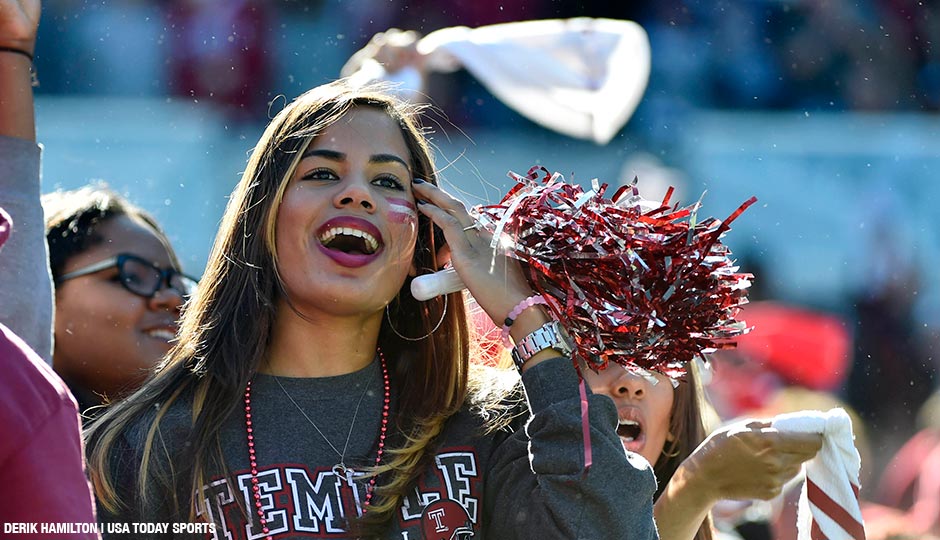Now Is the Time to Build the Temple Football Stadium

Temple Owls fans celebrate a touchdown against the Tulane Green Wave at Lincoln Financial Field on October 10th. The Temple Owls won 49-10.
Those who remember Peter Liacouras’ infamous early-’80s prediction that Temple’s football team would play in the Sugar Bowl by the end of the decade still chuckle when the grandiose proclamation arises. If you don’t remember the state of the program back then, picture a few thousand (if that) fans lolling around commodious Veterans Stadium while the object of their intent staggered about the concrete turf.
The Sugar Bowl? Those teams probably wouldn’t have been allowed near a sugar bowl at a coffee shop.
Nearly 35 years later, Liacouras’ vision for his school’s football program doesn’t seem so ridiculous. This week alone has produced the single greatest avalanche of publicity in the team’s 121-year history. ESPN GameDay comes to town Saturday. The Owls’ game against Notre Dame Saturday night will be televised on ABC and is arguably the biggest college football event in Philadelphia since the 1963 Army-Navy game, which was played 10 days after John F. Kennedy’s assassination. Sports Illustrated ran a full feature on Temple, not some one-pager in the front of the book.
Temple is 7-0 and ranked in the top 25 for the first time since the close of the ’79 season. Third-year coach Matt Rhule is already on some wags’ short lists for big-time coaching jobs that are either already open or soon to be available. The Owls are bowl eligible and hoping to win the American Athletic Conference title. There’s only one thing missing in this march to national legitimacy: An on-campus stadium.
If you believe media reports, that’s on the way. A parcel of land along the northwest corner of campus would be cleared to make way for a 35,000-seat impossible dream. The vision would be for students to walk to games, alums to return to the school’s burgeoning campus to be dazzled by new construction — and write checks for more improvement — and the program to end the nomadic life it has led since it moved out of Temple Stadium in 1978.
It’s all so perfect. It’s also a plan that could cause plenty of headaches. The biggest is financial. Although the school reports it has already secured pledges to fund a large share of the estimated $100 million price tag, it’s unlikely the whole nine-figure total will be reached. (Cost overruns are likely, too.) Adding an annual debt service payment to the already-hefty university commitment (estimated $7 million in 2014) to athletics won’t be too palatable. Although the end of annual rent costs for using Lincoln Financial Field will mitigate some of the debt pain, there could be some considerable short-term payouts. For an athletic department that already runs a deficit, that’s not good news.
There is also the small matter of drawing enough people to fill the place. Temple believes an on-campus stadium will be a magnet for fans and alums who don’t want to watch at the Linc, but the lack of parking, a dearth of tailgating opportunities and nightmare traffic scenarios might keep people away.
Perhaps the biggest concern is whether Temple can remain successful over the long run. This year’s run has been fabulous, but this is a program with four bowl appearances during its history and some truly wretched seasons in the not-so distant past. It doesn’t matter whether the Owls play at the Linc or on campus, 4-7 isn’t going to fill the seats in a pro town. Remember that two years ago, Temple cut other athletic programs to allow football to live. Could a stadium that hemorrhages money lead to more slicing and dicing?
You can bet the academic community would have something to say about all this, too. The tweed-jacket crowd wouldn’t be happy with more football deficits at a time when the school is piling millions into other campus projects.
Temple football faces perhaps its last moment of truth. It may never be more popular than it is right now and taking advantage of that celebrity is vital. It’s a good bet the stadium will rise in North Philadelphia, despite all of the horror stories from other urban schools (hello, Akron!) and the logistical issues that could torpedo the project. And we haven’t even mentioned potential community opposition, or the comically intractable Philadelphia City Council.
Still, this is the moment to take the chance. Temple isn’t going to drop football. And staying at the Linc means a constant flow of rent money settling into Jeffrey Lurie’s stuffed pockets. The school is rising, and adding an on-campus stadium to the new dorms and academic buildings will improve its status further. It’s going to take a creative, all-out effort to beat Notre Dame Saturday night, and that kind of brash approach is necessary to keep the program moving forward.
Build it. Be smart about it. But build it.
Peter Liacouras will thank you.


